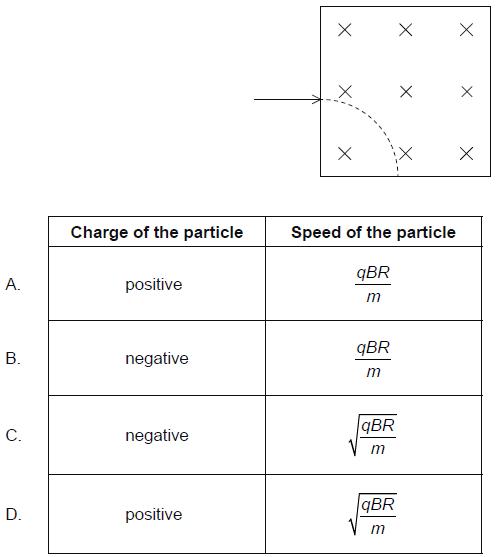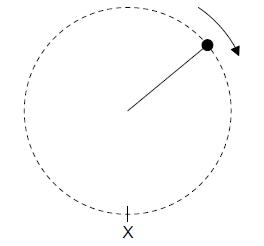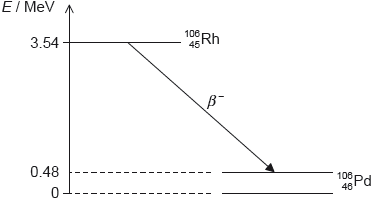
Topic 6 - Circular Motion & Gravitation
Question 1
SLPaper 1A satellite X of mass m orbits the Earth with a period T. What will be the orbital period of satellite Y of mass 2m occupying the same orbit as X?
Question 2
HLPaper 2Titan is a moon of Saturn. The Titan-Sun distance is times greater than the Earth-Sun distance.
The molar mass of nitrogen is .
Show that the intensity of the solar radiation at the location of Titan is .
Titan has an atmosphere of nitrogen. The albedo of the atmosphere is 0.22. The surface of Titan may be assumed to be a black body. Explain why the average intensity of solar radiation absorbed by the whole surface of Titan is .
Show that the equilibrium surface temperature of Titan is about .
The mass of Titan is 0.025 times the mass of the Earth and its radius is 0.404 times the radius of the Earth. The escape speed from Earth is 11.2 km/s. Show that the escape speed from Titan is 2.8 km/s.
The orbital radius of Titan around Saturn is and the period of revolution is .
Show that where is the mass of Saturn.
The orbital radius of Titan around Saturn is m and the orbital period is 15.9 days. Estimate the mass of Saturn.
Show that the mass of a nitrogen molecule is kg.
Estimate the root mean square speed of nitrogen molecules in the Titan atmosphere. Assume an atmosphere temperature of .
Discuss, by reference to the answer in (b), whether it is likely that Titan will lose its atmosphere of nitrogen.
Question 3
SLPaper 1A particle of mass m and charge of magnitude q enters a region of uniform magnetic field B that is directed into the page. The particle follows a circular path of radius R. What are the sign of the charge of the particle and the speed of the particle?

Question 4
SLPaper 1The mass at the end of a pendulum is made to move in a horizontal circle of radius at constant speed. The magnitude of the net force on the mass is .
 What is the direction of and the work done by during half a revolution?
What is the direction of and the work done by during half a revolution?
| Direction of | Work done by | |
|---|---|---|
| A. | towards centre of circle | zero |
| B. | towards centre of circle | |
| C. | away from centre of circle | zero |
| D. | away from centre of circle |
Question 5
HLPaper 1P and Q are two moons of equal densities orbiting a planet. The orbital radius of P is twice the orbital radius of Q. The volume of P is half that of Q. The force exerted by the planet on P is . What is the force exerted by the planet on Q?
Question 6
HLPaper 1A small ball of weight W is attached to a string and moves in a vertical circle of radius R.

What is the smallest kinetic energy of the ball at position X for the ball to maintain the circular motion with radius R?
Question 7
SLPaper 1A satellite is orbiting Earth in a circular path at constant speed. Three statements about the resultant force on the satellite are: I. It is equal to the gravitational force of attraction on the satellite. II. It is equal to the mass of the satellite multiplied by its acceleration. III. It is equal to the centripetal force on the satellite. Which combination of statements is correct?
Question 8
SLPaper 1An object at the end of a wooden rod rotates in a vertical circle at a constant angular velocity. What is correct about the tension in the rod?
Question 9
HLPaper 2There is a proposal to place a satellite in orbit around planet Mars.
The satellite is to have an orbital time T equal to the length of a day on Mars. It can be shown that
where R is the orbital radius of the satellite and k is a constant.
The ratio .
Outline what is meant by gravitational field strength at a point.
Newton's law of gravitation applies to point masses. Suggest why the law can be applied to a satellite orbiting Mars.
Mars has a mass of kg. Show that, for Mars, is about .
The time taken for Mars to revolve on its axis is 8.9 × 104s. Calculate, in m s–1,the orbital speed of the satellite.
Show that the intensity of solar radiation at the orbit of Mars is about 600 W m–2.
Determine, in K, the mean surface temperature of Mars. Assume that Mars acts as a black body.
The atmosphere of Mars is composed mainly of carbon dioxide and has a pressure less than 1% of that on Earth. Outline why the mean temperature of Earth is strongly affected by gases in its atmosphere but that of Mars is not.
Question 10
HLPaper 2Rhodium-106 () decays into palladium-106 () by beta minus () decay. The diagram shows some of the nuclear energy levels of rhodium-106 and palladium-106. The arrow represents the decay.

Bohr modified the Rutherford model by introducing the condition mvr = n. Outline the reason for this modification.
Show that the speed v of an electron in the hydrogen atom is related to the radius r of the orbit by the expression where k is the Coulomb constant.
Using the answer in (b) and (c)(i), deduce that the radius r of the electron’s orbit in the ground state of hydrogen is given by the following expression.
Calculate the electron's orbital radius in .
Explain what may be deduced about the energy of the electron in the decay.
Suggest why the decay is followed by the emission of a gamma ray photon.
